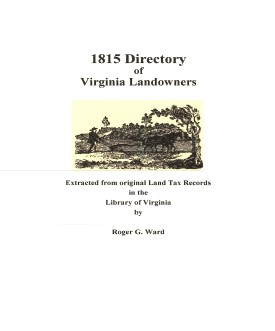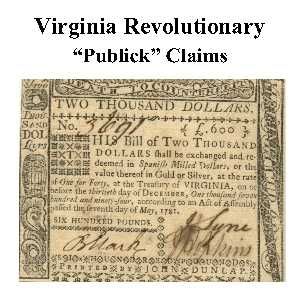BOTETOURT CO., VA MARRIAGES, 1770-1853
John Vogt & T. William Kethley, Jr. Two volumes, 1987, xi, 600 pages, figures, appendices,
map. Originally composed of the southern portion of Augusta County, Botetourt became the
parent county for a total of forty-four counties, including much of the West Virginia area. Bonds,
ministers' returns, and miscellaneous marriage data have been collected from the records in the
Virginia State Library, Archives Division, and from courthouse sources to comprise the 5,211
marriage records.
Surname list
[Bote] two-volume set 35.00
The above title is also available as a digital e-book in PDF format:
[EBOTE] $22.00 (electronic version)
 Botetourt Co. 1815 Directory of Landowners
by Roger G. Ward. 2005. 41 pages, map, 5 1/2X8 1/2.
Botetourt Co. 1815 Directory of Landowners
by Roger G. Ward. 2005. 41 pages, map, 5 1/2X8 1/2.
For a full description of the 1815 LAND DIRECTORY Records and a listing of available counties, see:
Individual County Booklets, 1815 Directory of Virginia Landowners
[Vd10] $9.00
The above title is also available as a digital e-book in PDF format:
[EVd10] $6.00 (electronic version)
 Botetourt Co. Revolutionary Public Claims
transcribed by Janice L. Abercrombie and Richard Slatten.. 2005. 49 pages, 5 1/2X8 1/2.
Botetourt Co. Revolutionary Public Claims
transcribed by Janice L. Abercrombie and Richard Slatten.. 2005. 49 pages, 5 1/2X8 1/2.
For a full description of the Virginia Revolutionary Public Claims and a listing of available counties, see:
Revolutionary "Publick" Claims series
To view a digital copy (pdf) of the index to this book, visit Index-Botetourt
(Close the pdf file with the left arrow to return to Iberian's catalog)
[Pc08] $7.75 (printed version)
The above title is also available as a digital e-book in PDF format:
[EPc08] $4.50 (electronic version)
For more records pertaining to BOTETOURT
COUNTY, VIRGINIA see also:
Guide to Virginia Militia Units in the War of 1812